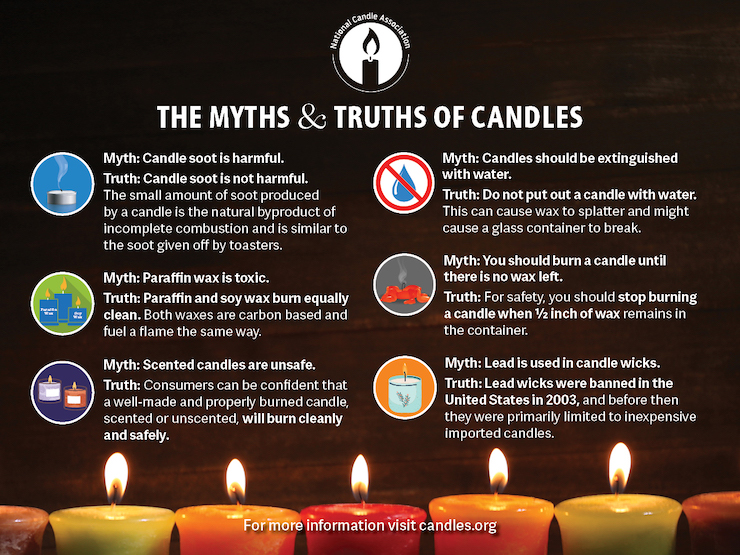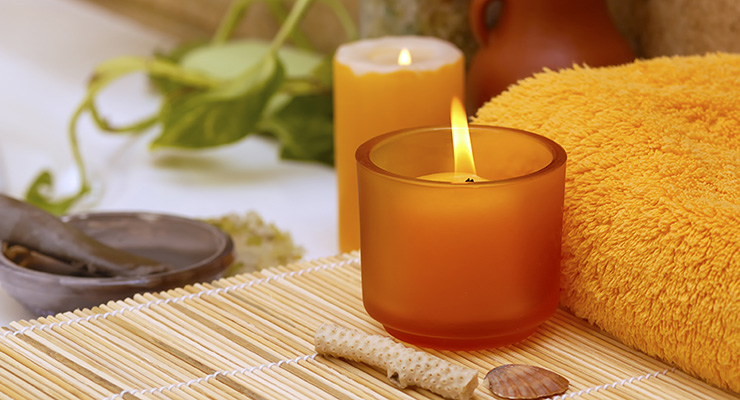Infographics
The Myths & Truth of Candles
The Myths & Truth of Candles
National Candle Association provides clarity on common consumer misperceptions about the materials and safety of this popular home fragrance product.
03.18.24
Consumers love candles—for both ambiance and fragrance. But many harbor misconceptions about candle safety, often fueled by social media, according to industry stakeholders like the National Candle Association.
The National Candle Association (NCA) has compiled the facts and dispelled myths surrounding candles, including in three major areas—indoor air quality, scented v. unscented candles and wax types.

Source: National Candle Association
While there is often of speculation on social media about candle waxes, with many promoting soy as a better wax, NCA notes that all types of quality candle waxes have been shown to burn cleanly, safely and in the same manner. Paraffin, soy, coconut, palm, and beeswax along with gels or synthetic waxes, are all equal in how they burn and perform.
Types of waxes are chosen not due to their “cleanliness” or “naturalness,” but due to their suitability for formulation, asserts NCA.
According to NCA, paraffin wax is great for holding scent and providing a strong scent throw. Coconut, soy, and palm wax are known for a faster burn since their melting point is lower. Beeswax provides a subtle hint of honey to your fragrance and gel waxes are great to get creative with since they’re often transparent. Candle manufacturers use a blend of waxes for superior performance and burning, said NCA.
Registration information is available here.
The National Candle Association (NCA) has compiled the facts and dispelled myths surrounding candles, including in three major areas—indoor air quality, scented v. unscented candles and wax types.

Source: National Candle Association
Indoor Air Quality
Candles are non-toxic and noncarcinogenic. Scented or unscented, there is no evidence that daily exposure will affect a person negatively, says NCA. According to the independent peer-reviewed study, Human health risk evaluation of selected VOC, SVOC and particulate emissions from scented candles, “candle emission testing was undertaken in environmentally controlled small and large emission chambers… conclud[ing] that under normal conditions of use, scented candles do not pose known health risks to the consumer," reported NCA.Scented or Unscented
There is no difference between burning a scented candle vs. an unscented candle, according to NCA, which states that its members are committed to manufacturing candles with ingredients scientifically proven to be safe. Proven in another research study, it was found that, “typical fragranced candles emissions are below the most conservative safe limits set by regulatory authorities and safety organizations.” Confirming there should be no concern when lighting up your favorite scent. The fragrances approved for candle use—whether synthesized or “natural”—do not release toxic chemicals, said NCA.Waxes
All candle waxes (paraffin, soy, palm, etc.) bought in the US are clean and safe to use, according to NCA.While there is often of speculation on social media about candle waxes, with many promoting soy as a better wax, NCA notes that all types of quality candle waxes have been shown to burn cleanly, safely and in the same manner. Paraffin, soy, coconut, palm, and beeswax along with gels or synthetic waxes, are all equal in how they burn and perform.
Types of waxes are chosen not due to their “cleanliness” or “naturalness,” but due to their suitability for formulation, asserts NCA.
According to NCA, paraffin wax is great for holding scent and providing a strong scent throw. Coconut, soy, and palm wax are known for a faster burn since their melting point is lower. Beeswax provides a subtle hint of honey to your fragrance and gel waxes are great to get creative with since they’re often transparent. Candle manufacturers use a blend of waxes for superior performance and burning, said NCA.
NCA's 2024 Annual Conference
NCA’s 2024 Annual Conference & Expo is scheduled for April 29-May 2 at the LINQ Las Vegas Hotel & Experience in Las Vegas, NV. NCA is marking its 50th anniversary at this year's event.Registration information is available here.
Related Searches:













